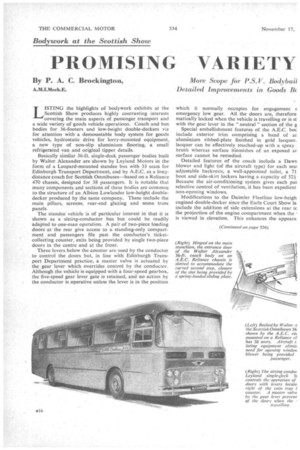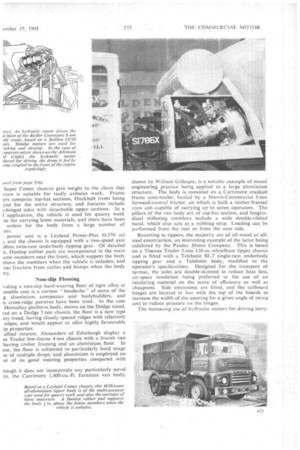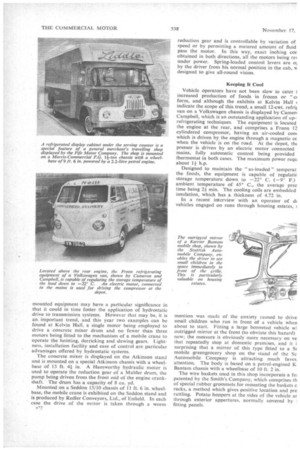Bodywork at the Scottish Show
Page 50

Page 52

Page 55

Page 56

If you've noticed an error in this article please click here to report it so we can fix it.
PROMISING VARIETY
By P. A. C. Brockington, More Scope for P.S.V. Bodybuil Detailed Improvements in Goods Bc
LISTING the highlights of bodywork exhibits at the Scottish Show produces highly contrasting interests covering the main aspects of passenger transport and a wide variety of goods vehicle operations. Coach and bus bodies for 36-footers and low-height double-deckers vie for attention with a demountable body system for goods vehicles, hydrostatic drive for lorry-mounted equipment, a new type of non-slip aluminium flooring, a small refrigerated van and original tipper details.
Basically similar 36-ft. single-deck passenger bodies built by Walter Alexander are shown by Leyland Motors in the form of a Leopard-mounted standee bus with 33 seats for Edinburgh Transport Department, and by A.E.C. as a longdistance coach for Scottish Omnibuses—based on a Reliance 470 chassis, designed for 38 passengers. it is notable that many components and sections of these bodies are common to the structure of an Albion Lowlander low-height doubledecker produced by the same company. These include the main pillars, screens, rear-end glazing and some truss panels.
The standee vehicle is of particular interest in that it is shown as a sitting-conductor bus but could be readily adapted to one-man operation. A pair of two-piece loading doors at the rear give access to a standing-only compartment and passengers file past the conductor's ticketcollecting counter, exits being provided by single two-piece doors in the centre and at the front.
Three levers below the counter are used by the conductor to control the doors but, in line with Edinburgh Transport Department practice, a master valve is actuated by the gear lever which overrides control by the conductor. Although the vehicle is equipped with a four-speed gearbox, the five-speed gear lever gate is retained, and no action by the conductor is operative unless the lever is in the position
which it normally occupies for engagement ( emergency low gear. All the doors are, therefore matically locked when the vehicle is travelling or is St with the gear lever in the " neutral " section of the g Special embellishment features of the A.E.C. boc include exterior trim comprising a band of at aluminium ribbed-plate finished in gold .lacquer. lacquer can be effectively touched-up with a spray brush whereas surface blemishes of an exposed ar surface cannot be remedied.
Detailed features of the coach include a Daws blower and light (of the aircraft type) for each seal adjustable backrests, a well-appointed toilet, a 71 boot and side-skirt lockers having a capacity of 521 Because the air-conditioning system gives each pas selective control of ventilation, it has been expedient non-opening windows.
Modifications to the Daimler Fleetline low-heigh engined double-decker since the Earls Court Show la include the addition of side extensions at the rear tc the projection of the engine eompartment.when the is viewed in elevation. This enhances the appeara the bus without increasing the transmission of engine noise, to the interior. Equipped with a Northern Counties 76seater body, the bus is intended for inter-city services for which tile lowest possible overall height may be of first importance. Whereas the height of the municipal bus exhibited at Earls Court was 14 ft., the height of the intercity vehicle has been reduced to 13 ft. 5 in. Fluorescent lighting is fitted on both decks, and interior panelling is of plastics material throughout—designed to outlast the life of the vehicle. Cleaning is facilitated by countersinking the heads of the attachment screws.
Demountable Box-van
Representing a sophisticated version of the concern's demountable cattle-container system, a demountable boxvan container is displayed this year by the Penman company. This is essentially a new concept and has been adopted by a number of well-known companies including I.C.I. and Guinness. Bodies carrying a payload of 161 tons have been loaded and unloaded in a few minutes with the aid of the system.
Two sets of ramped stands are employed and the body is fitted at the rear with two bracket-mounted rollers, which overhang the body, and with sets of rollers at the front attached to the ends of laterally extendible square-section support members incorporating retractable guide plates. The container is held in position for travelling by hookended bolt-section straps with turnbuckles and is mounted on a conventional type of light-alloy platform body. This
is based on Albion Chieftain chassis equipped v Penman three-seat cab.
The front stands have a greater span than the s set, which are located in line with the rear rollers. th ing is performed after removal of the straps by b2 the vehicle between the front stand with the extel members in the outer position, and the body is lifted the platform at both ends when the rollers make ci with the ramps, the thrust being taken by metal wi plates at the rear of the body. For loading, a " t bar" is fitted between the vehicle body and container moves through an arc as the container is lowered on platform.
The I.C.I. body exhibited on the stand is of all-alum construction, outside dimensions comprising a leng 14 ft., a width of 7 ft. and a height of 5 ft. 6 in. framing is constructed of triangulated members an body is double skinned. I.C.I. Impalco alloy is throughout.
Although the small number of light-alloy bodies Show suggests that aluminium construction is ground, discussions with operators and builders of bodied tippers, vans and platform vehicles indicate th people who use this type of structure have reaped a v while benefit. It is now unusual to find an alloy hod has not been built with due regard to the characterist the metal.
For example, reports on the Wilkinson all-alum multi-purpose tipper, displayed by the Leyland con (Continued on page 537)
Super Comet chassis) give weight to the claim that tium is suitable for really arduous work. Frame ers comprise top-hat sections, Huckholt rivets being yed for the entire structure, and features include !-hinged sides with detachable upper sections. In a 1 application, the vehicle is used for quarry work .so for carrying loose materials, and there have been orders for the body from a large number of ors.
power unit is a Leyland Power-Plus 0.370 oil and the chassis is equipped with a two-speed axle dbro twin-ram underbody tipping gear. Of detailed ;t, Dunlop rubber pads are incorporated in the main ame members near the front, which support the body ibove the members when the vehicle is unladen, and ves freedom from rattles and bumps when the body )t y.
Non-slip Flooring
viding a non-slip hard-wearing floor of light alloy at onable cost is a current headache of some of the g aluminium companies and bodybuilders, and is cross-ridge patterns have been tried. In the case Homalloy platform body, shown on the Dodge stand, ted on a Dodge 7-ton chassis, the floor is a new type ety tread, having closely spaced ridges with relatively edges, and would appear to offer highly favourable ip properties.
allied interest, Alexanders of Edinburgh display a es Trader low-frame 4-ton chassis with a biscuit van having timber framing and an aluminium floor. In ase, the floor is subjected to particularly hard usage se of multiple drops, and aluminium is employed on nt of its good wearing properties compared with hough it does not incorporate any particularly novel vs, the Carrimore 1,400-cu.-ft. furniture van body, shown by William Gillespie, is a notable example of sound engineering practice being applied to a large aluminium structure. The body is mounted on a Carrimore cranked frame semi-trailer, hauled by a Morris-Commercial 5-ton forward-control tractor, on which is built a timber-framed crew cab capable of carrying up to seven operators. The pillars of the van body are of top-hat section, and longitudinal stiffening members include a wide double-ribbed band, which also acts as a rubbing strip. Loading can be performed from the rear or from the near side.
Reverting to tippers, the majority are of all-wood or allsteel construction, an interesting example of the latter being exhibited by the Paisley Motor Company. This is based on a Thames Trader 5-ton 138-in.-wheelbase tipper chassis and is fitted with a Telehoist SL.7 single-ram underbody tipping gear and a Telehoist body, modified to the operator's specifications. Designed for the transport of tarmac, the sides are double-skinned to reduce heat loss, air-space insulation being preferred to the use of an insulating material on the score of efficiency as well as cheapness. Side extensions are fitted, and the tailboard hinges are located in line with the top of the boards to increase the width of the opening for a given angle of swing and to reduce pressure on the hinges.
The increasing use of hydraulic motors for driving lorry mounted equipment may have a particular significance in that it could in time foster the application of hydrostatic drive to transmission systems. However that may be, it is an important trend, and this year two examples can be found at Kelvin Hall, a single motor being employed to drive a concrete mixer drum and no fewer than three motors being fitted to the mechanism of a mobile crane to operate the hoisting, derricking and slewing gears. Lightness, installation facility and ease of control are particular advantages offered by hydrostatic systems.
The concrete mixer is displayed on the Atkinson stand and is mounted on a special Atkinson chassis with a wheelbase of 13 ft. 41 in. A Hamworthy hydraulic motor is used to operate the reduction gear of a Mulder drum, the pump being driven from the front end of the engine crankshaft. The drum has a capacity of 8 cu. yd.
Mounted on a Seddon 15/10 chassis of 11 ft. 6 in. wheelbase, the mobile crane is exhibited on the Seddon stand and is produced by Redler Conveyors, Ltd., of Enfield. In each case the drive of the motor is taken through a worm
P,12
reduction gear and is controllable by variation of speed or by permitting a metered amount of fluid pass the motor. In this way, exact inching cor obtained in both directions, all the motors being rel under power. Spring-loaded control levers are ol by the driver from his normal position in the cab, in designed to give all-round vision.
Keeping It Cool
Vehicle operators have not been slow to cater i increased production of foods in frozen or " form, and although the exhibits at Kelvin Hall indicate the scope of this trend, a small 12-cwt. refrif van on a Volkswagen chassis is displayed by.Cameri Campbell, which is an outstanding application of up-i refrigerating techniques. The equipment is located the engine at the rear, and comprises a Freon 12 cylindered compressor, having an air-cooled com which is driven by the engine through a magnetic cc when the vehicleis on the road. At the depot, th( pressor is driven by an electric motor connected mains, fully automatic control being provided thermostat in both cases. The maximum power requ about 1-1 h.p.
Designed to maintain the "as-loaded " temperat the foods, the equipment is capable of regulatir storage temperature down to —22° C. (-9° F.) ambient temperature of 45° C., the average prec time being 2+ mm. The cooling coils are embedded insulation, which has a thickness of 4.72 in.
In a recent interview with an operator of (I( vehicles engaged on runs through housing estates, !
mention was made of the anxiety caused to drive small children who run in front of a vehicle when about to start. Fitting a large bonneted vehicle wi outriggecl mirror at the front (to obviate this hazard) new; the measure is obviously more necessary on ye that repeatedly stop at domestic premises, and it i surprising that a mirror of this type fitted to a Sr mobile greengrocery shop on the stand of the Sc Automobile Company is attracting much favot attention. The body is based on a petrol-engined K Bantam chassis with a wheelbase of 10 ft. 2 in.
The wire baskets used in this shop incorporate a fe patented by the Smith's Company, which comprises th of sPecial rubber grommets for mounting the baskets e racks, a method which gives positive location and pre rattling. Potato hoppers at the sides of the vehicle ar through exterior appertures. normally covered by fitting panels.




















































































































